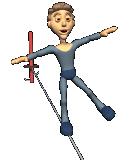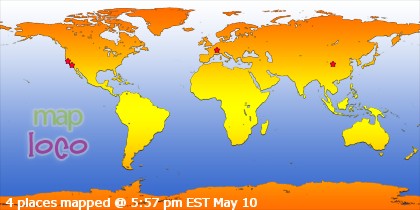THE DAY CLYDE BEATTY
CAME TO TOWN
By KENT HOLSATHER
for TheColumnists.com
Just the other day I was rummaging through some old photos I’d come across at our local museum. I’m a sucker for nostalgia and I can’t resist the trip up to the archives department for a fix every now and then.
The box that read 1955 caught my eye, so I placed it on a study table and proceeded to plow through the prints. It was an especially tedious chore considering that I had to wear white “archival gloves” to handle the pictures.
An hour passed before I pulled out a photo that snapped my memory cells to attention. It was a picture of Clyde Beatty receiving a gift from a local city councilman. At that moment, memories long forgotten suddenly sprang to life.
CLYDE BEATTY! He was the world's most famous circus superstar, something we don't seem to have in our culture anymore. He was, in fact, the world's greatest wild animal trainer. WE used to call them "lion-tamers." Do today's kids even know what that means?
The memories came flooding back. I was five years old and I had never seen a circus in my rather short existence. That was all about to change in one glorious night of laughter, music and derring-do.
A large circus visiting a small town like Bellingham, Washington, was a big deal back in the 50s. The local paper worked hard to cultivate interest by splashing gaudy layouts of Clyde Beatty and his assorted felines in the evening spreads. By all accounts, it worked well.
On the morning of July 19th, 1955, a train loaded with performers, animals, tents and roustabouts pulled into town. The Clyde Beatty Circus still moved on rails--it would convert to trucks in 1957--and it usually arrived just before dawn to assure that the Big Top was up and ready by the first performance that afternoon.
As noon drew near, Clyde utilized one of the oldest advertising tricks in the book of circus entertainment. He put on a “circus parade.” Clyde used to say “give the customer a free taste and he’ll clamor to buy the whole dinner.”
State Street--our main commercial street--was jammed with people to watch the animals and performers parade from a staging area near the center of town out to a vacant lot where the big top had been set up.
My brother and I found the perfect perch atop the hood of a 1951 Pontiac. Our vision was totally uncompromised, even in that era of men’s Fedora hats and women with padded shoulders. From our rampart, we watched as camels and elephants lumbered by, prodded on by their keepers. We were especially impressed with the refuse dropped by the elephants. We were small town kids who had only just begun to open our eyes to the bigger world beyond our backyard so the big-time piles in front of us were real eye--and nose--openers.
Clowns with endless supplies of seltzer bottles ran, strolled, rolled and cart-wheeled down the street and anyone within seltzer range was fair game. They were followed by performers of all sizes, shapes and at least two, possibly three genders.
Everyone seemed to be represented: the fat lady, the giant, the alligator man, tiny people, jugglers and horsemen. They were all there for us to gawk at, but the best was saved for last. At the very end of the parade came the star attraction. Riding atop the loudest calliope that I had ever heard (and the only one I'd heard up to that time) was the epitome of Sigfried and Roy rolled into one incredible character: Clyde Beatty!
He looked like a movie star in his white chapped pants, pith helmet, whip and pistol. He ran the most celebrated animal act in the world. In the 1930s and 40s, he really was a movie star, appearing in such films as "The Lost Jungle," "Darkest Africa," Africa Screams" and "Perils of the Jungle." Maybe they were marginal films at best and down right horrible at their worst, but his movies didn’t diminish the fact that Clyde Beatty was one of the most recognized performers of his generation.
Born in 1903 in Bainbridge, Ohio, Clyde began entertaining the neighborhood kids when he was nine years old. His first animal tricks were performed with dogs and cats borrowed from his friends. As a young man, he got a job training polar bears in a circus and when the resident lion tamer had a nervous breakdown, Clyde took over the lion act with one bit of advice, “Always keep a clear path to the exit door.”
Clyde’s fearlessness outweighed his technical skills in his early years and it was well known among the circus community that when Clyde stepped into the ring, there were three possible outcomes. 1. A triumphant exit to applause. 2. A mad dash to the exit or 3. Being dragged out of the cage by the clowns after a mauling. That No. 3 outcome wasn't so rare either. In fact, it happened several dozen times over his career.
His popularity skyrocketed when he was hired by the great showman, Zack Terrell, to run the big cat show at the Chicago Worlds Fair of 1933. He was in demand to highlight the center ring of circuses across the United States and worked in several over the next 30 years.
Clyde was a tireless self promoter who had his own radio show in the 1940s and early 1950s, featuring stories of himself and his circus. The kids ate the stories up with gusto. It helped keep the seats full at his performances until television came along and began to eat his industry up with an equal gusto.
And here he was in my hometown--in person!
After the parade finished, everyone followed the calliope to the circus grounds. There was a mob around the midway as people bought tickets to the show in the Big Top and others milled around the side shows. As my parents stood in line to buy tickets--80 cents for kids and $1.45 for adults--my brother and I walked over to where the giant stood. As we stared, a lady came up and offered to sell us a ring that was said to be the same size that the giant wore. My brother dug into his pocket and shelled out the 25 cents needed for the transaction to be made and as the woman walked away, my brother held it up in awe. Its golden finish sparkled in the afternoon sun and it was big; big enough for him to put two fingers through it at once. Our world was expanding by the minute.
We browsed around the side shows for a few minutes until it was time to head into the Big Top. Flooding into the tent like cattle, we scampered up into the bleachers with our folks and grabbed the best seats we could find.
What I remember most of that day was the smell of sawdust. It was a smell that has imprinted itself on my brain for all time and will most likely be with me until the day I draw my last breath.
After about a 15 minute wait, the show opened with a grand entry around the perimeter of the three rings. It was the circus parade all over again, only indoors. The crowd applauded as the different acts marched by and were introduced to the audience by the Ringmaster.
When the grand entry was completed, the acts split into groups and began their performances in the 3 rings at the same time. It was mind-boggling trying to watch 3 acts simultaneously. I gave up trying to keep up with all of the action so I concentrated on the center ring where several women twisted and turned from suspended ropes. They worked their act for about 15 minutes before they were replaced by 20 clowns exiting from a clown car and after another 15 minutes, they in turn were replaced by another act. This went on for a couple of hours until the big finale.
A group of circus workers ran out and assembled a large caged ring. They then brought out several lion and tiger cages that opened into the ring. All was set as the tent grew dark except for a spotlight over the ring. It was “show time”
“Ladies and gentlemen, the greatest animal trainer in the world!” the Ringmaster literally bellowed the words: “Clyyyyyyyde Beattyyyyyyy!”
The crowd roared and I excitedly spilled my popcorn on the back of the man in front of me. Whirling around to face an embarrassed 5 year old, he just smiled and turned back to the show. The circus will do that to you.
Clyde was famous for his ability to mix different breeds of lions and tigers into one show. Some of the cats were natural enemies and on more than one occasion faced off in lethal encounters. The climax to Clyde’s act was to have 16 lions and tigers lay down next to each other in perfect harmony and after lots of whip lashing, pistol shooting and chair poking, he did just that. That was as big-time as it got in the Big-Top and I was there to see it all.
As it turned out, that was the last real old-fashioned circus I ever attended. I went to a Ringling brothers Barnum and Bailey circus in the Coliseum in Seattle many years later, but it was more like a Vegas show than a circus.
It was ironic to find out the Clyde Beatty died exactly 10 years to the day after I saw him on that warm July day in 1955. He’s buried in Forest Lawn cemetery in Hollywood Hills and that seems appropriate enough.
A lot has changed in the 40 years since Clyde passed away and by today’s standards, he probably would have been in constant trouble with animal rights groups. The public attitude towards captive animals and animals used for entertainment has changed immensely since the 1950s. “Rights” that the animals desperately needed are being enacted and enforced on an ever widening scale all over the world.
Clyde was utterly fearless and a tremendous entertainer, but he was also a product of his era. It was a time when most of the great zoos still kept animals in small cages and the rights of animals were still just being developed. It was also a time when the lion tamer wore a pith helmet, carried a pistol with blanks, cracked a whip and wore his courage on his shirt sleeve.
©2005 by Kent Holsather. This column first posted March 28, 2005.
Wednesday, April 23, 2008
Subscribe to:
Post Comments (Atom)















1 comments:
Good find! Thank you for sharing it.
Post a Comment